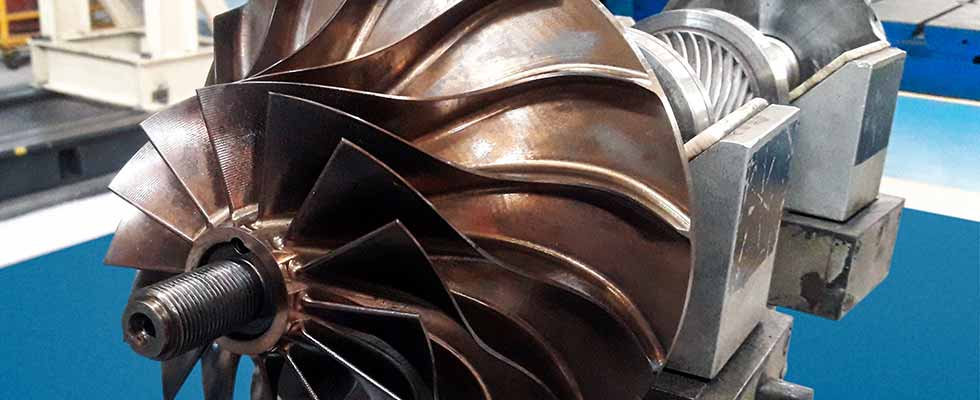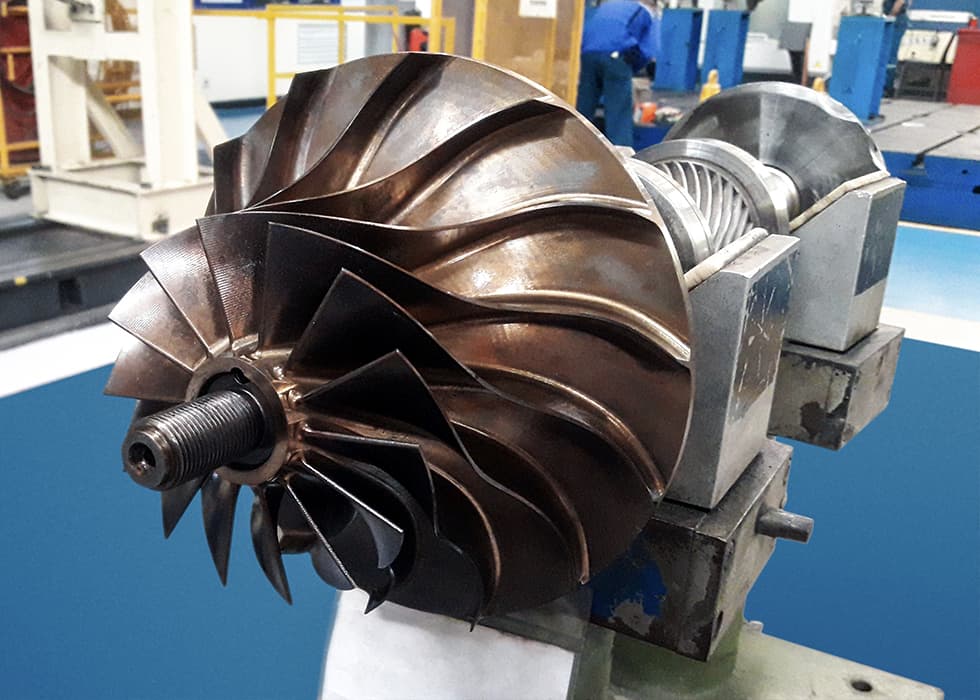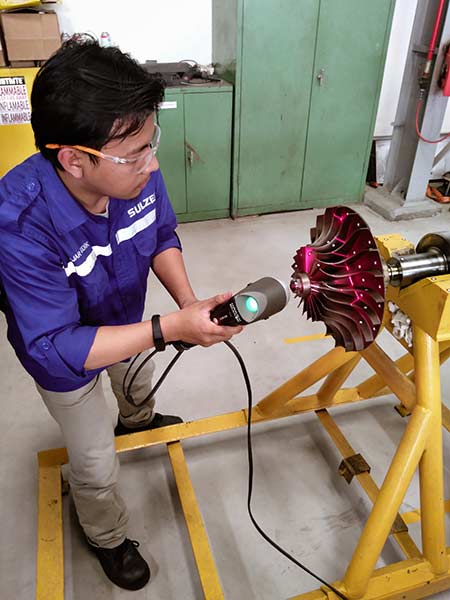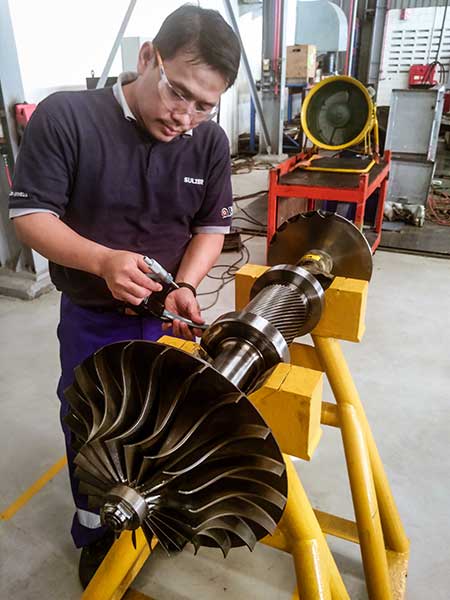
Many industrial processes rely on compressors for a host of tasks, from powering machinery to squeezing industrial gases for storage and transportation. Replacing important parts quickly is essential for continued productivity. When one of its main compressors failed, a company in the Philippines faced high costs and the prospect of a long wait for a critical replacement part.
 IMAGE 1: The complex impeller geometry was recreated using digital modeling. (Images courtesy of Sulzer)
IMAGE 1: The complex impeller geometry was recreated using digital modeling. (Images courtesy of Sulzer)Compressors can be large, consuming hundreds of kilowatts (kW) of power, but the integral component is a precision-engineered, high-speed impeller, which can be just a few centimeters (cm) in diameter.
Finding replacement parts can be a challenge when assets suffer from unexpected failures. When spare parts are not available, creating a new part may be the best alternative. In this scenario, reverse engineering is a critical capability to ensure success.
Establishing Principles
Reverse engineering can be a cost-effective and swift solution for refurbishing legacy assets, minimizing downtime and improving reliability as well as performance. Creating new components as direct replacements or with improved materials, geometry or dimensions can ensure continued performance.
The process involves establishing the proper materials, heat treatments, dimensions and tolerances as well as any surface treatments that will optimize performance. Each stage requires considerable expertise and advanced facilities to deliver a new component that will provide improved reliability.
Of course, simply measuring the component and creating a new one is not the answer. Any wear must be assessed and comparisons with mating parts need to be made to establish the correct dimensions of the new part. This is just the beginning; analysis of the component is critical to determine the most suitable material and design, which may be improved using modern manufacturing techniques.
New Manufacturing Processes
One process used is additive manufacturing (AM), which is suited to the production of single or low volume components.
Direct AM can be achieved in several alloys, such as 316L stainless steel and Inconel 625, using laser powder bed melting to make more complex components.
Indirect AM can print replicas of the part required in plastic or wax. These are then encased in a ceramic shell, which is heated to melt the wax/plastic to fire the ceramic. This produces a hollow mold that can be filled with metal alloy and, once allowed to cool, the ceramic shell is broken away to leave the final part.
 IMAGE 2: Laser scanning offers a quick and precise method of data acquisition. (Images courtesy of Sulzer)
IMAGE 2: Laser scanning offers a quick and precise method of data acquisition. (Images courtesy of Sulzer)The detail and surface finish achieved through this process can improve quality and reduce the time required for tooling to create new parts.
With the right resources, maintenance providers can recreate parts that have suffered considerable damage, even if the original drawings are unavailable. Components operating in rotating equipment are subjected to considerable wear during their lifetime.
Turbine blades and generator rotors, as well as impellers from pumps or compressors, are just some of the critical parts reverse engineering capabilities support. Reverse engineering offers users further benefits in improved machine performance through engineered upgrades to the components.
Case Study
For one company in the Philippines, damage to this vital part was the cause of a prolonged period of expensive disruption.
When a large compressor failed, investigations showed that the machine had been operating out of balance for some time. The resulting vibrations had caused such extensive damage to the machine’s 7.4-inch (188 millimeter [mm]) diameter impeller that the part was beyond repair.
Digital Modeling & Measurement
The damaged impeller and shaft were removed from the casing and shipped to a repairer’s facility in Indonesia. Once there, the local engineering team set about collecting all the data needed to recreate the part.
Using a combination of laser scanning technology and conventional measurements, the team collected digital and dimensional inspection data to build a complete 3D representation of the impeller.
The data was then used to build a 3D solid model of the replacement component. The damage to the impeller was
extensive, so the design team had few complete surfaces they could use as a basis for the model.
By applying engineering analysis to the geometry of the broken part, however, they were able to “undo” the damage digitally and determine the precise geometry of the original component.
While experts were working on the geometry, their colleagues were continuing to work to reverse-engineer the component.
 IMAGE 3: Final dimension checks ensured the fit when the impeller shaft was reinstalled.
IMAGE 3: Final dimension checks ensured the fit when the impeller shaft was reinstalled.They used X-ray fluorescence (XRF) analysis to establish the exact chemical composition of the impeller. This allowed them to source the same alloy to manufacture the replacement.
Finally, the team used zebra analysis to determine the surface continuity quality in the 3D model. This process projects lines onto the surface of the component and examines the surface finish required for the new part during the machining process.
Machining Expertise
With the model, material and relevant manufacturing information now available, it was time for computer numerical control (CNC) machining specialists to step in. CNC machine tools offer a precision, automated process that use code from 3D drawings to create new components.
A manufacturing team in Houston produced the replacement part, which was machined from a single block using five-axis milling techniques.
After surface finishing, the part was spin tested at high speed in Houston to check for any imbalance before shipment to Indonesia. The Indonesian team assembled and balanced the new impeller on the original shaft before returning it to the customer for installation in the machine.
The compressor was a small, but complex, component and its performance was critical to the operations.
Close cooperation between the engineering teams working on opposite sides of the world allowed the maintenance specialists to deliver a solution on a time scale that met the customer’s needs, also while delivering a 40 percent cost saving.

